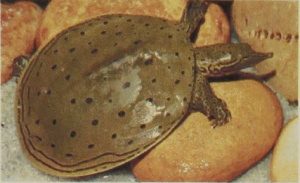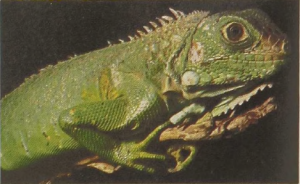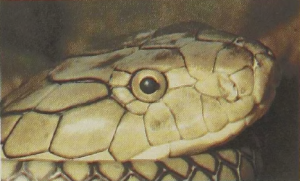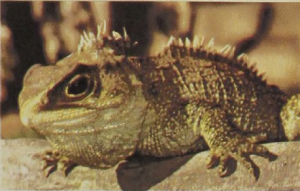Return to Reptiles of the World
What Are Reptiles?
The reptiles we see today represent the remnants of the group that engaged in the most successful adventure in history—the emergence from the waters in which animals originated and the invasion of dry land. Reptiles are not fishes, which tend to be aquatic animals that are clearly adapted to water. Nor are they amphibians, members of groups that evolved limbs and crawled away from the water only to remain tied to its vicinity by the aquatic habits of their young. Reptiles are clearly distinguished from fishes and amphibians by the development of the amniotic egg. This egg includes not only a hard outer shell, but also a set of internal membranes that enfold the growing embryo in a sheltered pool of amniotic fluid while the stored yolk is transformed into a baby snake or a turtle.
While reptiles are amniotes, so are birds and mammals. However, both of the latter clearly differ by their ability to maintain an elevated body temperature. Birds and mammals adjust their metabolic, or food utilization rate, to compensate for body heat lost. Reptiles cannot do this: they can only warm or cool their bodies by moving to a warmer or cooler spot of their environment. Thus turtles bask on a log and then cool off in the water when they get too hot. Consequently, reptiles may be defined as ectotherm amniotes.
Reptilian Adaptations
Reptiles are the group that first showed the major specializations that later made mammals successful. We must briefly treat these special adaptations in order to understand the reptilian success.
Temperature Regulation Most fish have the same temperature as the water in which they swim. They warm up somewhat when they swim faster: large fish have core temperatures higher than those of the surrounding waters. However, fish cool as they slow down and show little evidence of temperature control.
Reptiles have not yet developed a metabolic pattern that gives them the scope (ability to increase metabolic rate) to maintain an elevated temperature. On the other hand, they have developed fairly accurate temperature sensors within their brains, and these steer their “ectothermal” behavior. Unless motivated by a conflicting drive, such as the activity of food objects or predators or the location of shelter sites, they will keep their body temperature very close to a preferred level that is maintained throughout the day’s activity.
Metabolism Recent studies show that a running lizard uses about as much energy as a running mouse, squirrel, or chipmunk of the same weight running at the same speed. A snake sliding on its belly uses less {it is not carrying its weight off the ground), and swimming reptiles (or fish) use still less. Reptiles do have a lesser metabolic scope than do mammals. This limits the length of time that they can sustain running and foraging activities. Consequently, a lizard may dash as fast as a mouse but will rest thereafter to recover its energy store. The higher an animal’s body temperature the greater its metabolic rate, but not necessarily its metabolic scope. The rate of oxygen transport (from air to lung to blood to cell) soon becomes limiting in reptiles.
Water Balance Reptiles need water for many purposes. If animals cannot drink, the concentration of salt in their blood, lymph, and tissue fluids increases and soon harms the cells. Reptiles sometimes use water to control their temperature: evaporation allows animals to pass heat to the outside air. While no reptile can sweat, some cool themselves by panting, but this generally indicates extreme temperature stress.
Water is also used to carry the waste products of metabolism through the kidneys. Fishes and amphibians flush their kidneys with enormous quantities of water. Life on dry land has caused rdptiles to limit such wasteful usage. Excessive water loss has been controlled by transforming the skin into a barrier that will reduce evaporation and by developing an alternate mechanism for discharging metabolic wastes. The integumentary barrier is composed of a substance called keratin, first used for this purpose by amphibians but made much more effective in reptilian skin. The alternate mechanism for discharging metabolic wastes involves the production of uric acid instead of ammonia or urea. A slight change in acidity causes this uric acid to crystallize in the cloaca, where the free water may then be resorbed to be used again. The urine of reptiles and many birds is a sludge of white crystals.
Reproduction Reptiles developed the amniotic egg, and all of their reproductive patterns reflect this specialization. Turtles, crocodilians, rhynchocephalians, and some squamates lay eggs. Many members of all three groups of squamates deposit the eggs only a few days before hatching or retain them until they are just about to hatch. Other forms retain the eggs until term, and the young are born alive.
In the latter case no outer shell is laid down. The soft outer membrane of the egg adheres closely to the wall of the oviduct of the mother. Wall and membrane are permeable to water and nutrients, which pass inward from the mother, and to waste products, which pass outward from the embryo. This permeable contact represents one of the earliest stages of placentation, parallel to the process later developed in mammals. In placental animals the egg’s yolk contains only part of the raw materials required to form an embryo; the rest is provided by the mother between fertilization and birth.
Size and Growth Reptiles generally differ from mammals in having indeterminate growth. This means that they do not stop growing when they become sexually mature but continue to do so, though at a much slower rate, throughout the rest of their lives. Continuing growth, of course, makes it difficult to determine the maximum size achieved by a particular species. Consequently, a statement like “They tend to be about a foot long” refers to an average size, while “They grow up to 3 feet in length” refers to the maximum. Indeterminate growth also accounts for statements that some species of crocodilians or turtles are smaller than they used to be: hunting pressure on the population may have kept most specimens from becoming old enough to grow very large. Since the largest specimens tend to be most attractive to hide hunters, this is an obvious mechanism for reducing the average size.
Who Are the Reptiles?
The invasion of the land and the somewhat later invention of the amniotic egg opened up a whole new environment to the earliest reptiles. They could move into the drier areas, away from permanent water, and fossil records show an amazing diversity of forms that did so. We see many small species but also some truly spectacular large ones. Certainly dinosaurs are known to everyone. In the same way as such mammals as whales and seals later invaded the seas, so did the reptiles—as dolphin-like ichthyosaurs and turtle-like plesiosaurs. Birdlike pterosaurs flew—or at least glided—and may have approached endothermy, as some of them seem to have been covered with hair. We know that these various fossil reptiles fed on plants, on invertebrates, on fishes, and on each other. Once they were common; then, suddenly, during a relatively briefs million years, most of them became extinct for reasons that are still unclear and much debated.
Only six groups (orders) of the Class Reptilia survive today. Perhaps most primitive are the turtles, order Testudines, a group in which the shoulder and pelvic girdles have moved to the inside of a bony shell and achieved a curious box-like construction, unique among the vertebrates. Turtles, which bury their eggs in the soil and neither guard them nor practice parental care, occur in a wide belt throughout the temperate and tropical zones.
There are 20 species of the order Crocodilia, which derive from a line of reptiles that later gave rise to birds. They are relatively large aquatic animals that range around the tropical and subtropical parts of the world. Some species exceeded 20 feet in length, though such enormous beasts are now rare. Surviving crocodilians are probably insignificant relatives of some now-extinct forms that apparently reached lengths of 60 feet or so. All species that evolved during the Recent epoch are egg-layers and carnivores, and even the smallest species exceeds 3 feet in length.
Next there is the order Rhynchocephalia or beak-nosed reptiles. A single living species, the Tuatara, survives precariously on a few islands off New Zealand, most members of the order having become extinct long ago.
Finally, we come to the superorder Squamata or scaly reptiles that includes the largest number of the successful groups living today. The superorder Squamata includes three orders—amphisbaenians, lizards, and snakes. Rigid definitions of such groups tend to become technical, but amphisbaenians (formerly called worm-lizards) are slender reptiles with a thin, flexible, and annulate (ringed) skin subdivided into squarish segments. The head is specialized for ramming and forming tunnels, and the ear for hearing prey while underground. Some 130 species of the order Amphisbaenia range from Patagonia to Florida in the New World and from South Africa to Spain, Turkey, and Iran in the Old.
The approximately 3,100 lizards (order Sauria) include a bewildering array of species. More than 20 families are currently recognized. Most species have limbs and a more or less elongate tail; they are covered with a scaly skin studded with “scales” which are tuberculate—flattened or conical projections of keratin. They range from the Arctic circle (in Europe) to the southern tips of South America, Africa, and India, as well as across Australia and New Zealand.
Snakes (order Ophidia) seem to be a more recent development, and the approximately 2,300 species are apparently the group of reptiles most successful today. Except for their absence from oceanic islands, they have a distribution approximately equivalent to that of lizards. Flowever, the marine sea snakes extend this range, for they occur across vast regions of the Indian and Pacific Oceans. Snakes are always limbless, though a few species retain remnants of the pelvic girdle. Plead and jaws are highly mobile, and most snakes move the two halves of the lower jaw separately by alternating left and right grasping pulls while ingesting their food. They characteristically swallow their prey whole, stretching around large food items.
Within this general body plan we see an amazing array of specializations. For example, some snakes have specialized for a single food item such as bird eggs, the soft portions of snails, fish eggs, and centipedes.
Understanding and Study
Much has been learned about reptiles. Some of the diverse aspects of our interest are stated here. Other subjects will be introduced in the following accounts. Actually, however, we do not yet know very much even about the numbers and kinds of reptiles, particularly of those found in tropical regions. Some species are likely to become extinct before we have discovered that they exist. Their discovery and description are an international undertaking, and the Latin names of families given in the Table of Contents and of species in the text serve as an international index to the facts which we have thus far discovered.
As we begin to know Who the many reptiles are, we can ask more significant questions, such as How do they utilize their environment? How much of their energy do they obtain from the plants and animals upon which they feed and how much directly from the sun by basking? The many curious reptilian activities are not randomly assembled, charming facts in natural history: instead they are strategies for survival and success under sometimes quite inhospitable circumstances. The questions become even more interesting when we ask how numerous reptiles can live in one area. How do they divide up the resources? Why is it possible for 20 kinds to survive in one place and only a dozen in another?
Seen from this viewpoint, every change in anatomy or structure, in physiology, and in behavior may reflect an adaptation to local circumstances. The understanding of reptiles then leads to an improved understanding about the ways all animals interact with each other and with their physical environment.
Some reptiles may be appreciated for their intrinsic beauty. A look from the basis of their complex specialization teaches us to appreciate even more the intricate web of interlocking specializations. Now that we have a general idea of reptiles, let us look at individuals.



